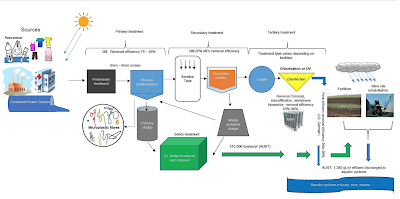 |
| Figure 2. Illustrates the interaction effects of the micro plastics with waste water relevant environmental hazardous and degradation effects. |
Over 320 million metric tonnes of plastic applications have been created since plastic has been in use. Micro plastics are very small pieces of plastic that can cause pollution, they are comprised of many/any type of plastic fragments that are less than 5mm in length. According to this study micro plastics have begun to enter terrestrial and aquatic ecosystems by way of water waste treatment plants around the world. These plants are not designed to metabolize plastic materials, they are sedimentation, flotation, and filtration plants. Meaning that the process of cleaning the micro plastic involves a 3 treatment level process, with each level removing visible plastics ranging from big too small. Although theses plants are effective micro plastics still make it through to the filtered and waste dumping water that end up in different environments. The way these micro plastics can affect the environment is by absorbing the heavy metals ions that are around them, like Al, Fe, Mn, Cu, Zn, Pb, Ag, Cd, Co, Sr, Mo, Sb, Sn, and Ni and with the ability of plastics to act as a 'transport vector' to these toxic metals, can be very harmful for agriculture and landfilling. If humans were to inhale these micro plastics fibers they could cause tumors within lung tissues, dermatitis, and endocrine disruption leading to cancers and sometimes death. This study has proposed methods for solving this problem and that is by biodegradation and addressing the methodological gaps within those water waste plants.
Orignial Article:
Subash Raju, Maddison Carbery, Aswin Kuttykattil, Kala Senathirajah, S R Subashchandrabose, Geoffrey Evans, Palanisami Thavamani. (2018). Transport and fate of microplastics in wastewater treatment plants: implications to environmental health. Environmental Science and Bio/Technology v17 n4 (201812).
|

No comments:
Post a Comment